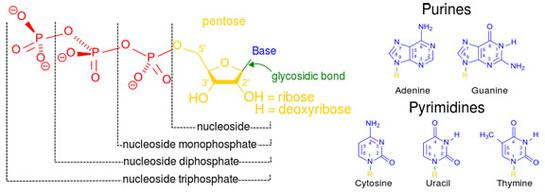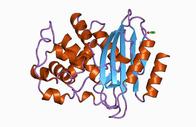 | ||||
Difference Between a
Genome, Proteome & Metabolome
A genome is the complete genetic sequence of an organism; the blueprint for the cellular proteome, which, in concert with the environment, determines the metabolic capabilities of the cell.
Article Summary: Living things can be studied and classified based on their genome, the protein products derived from those genetic instructions and the molecules that organisms are able to metabolize.
Genome, Proteome & Metabolome Compared
Color-coded chromosomes.
 | ||||||
SPO VIRTUAL CLASSROOMS
Nucleic acids are large organic molecules made of smaller molecules called nucleotides. Each nucleotide is a monomer, or building block of nucleic acid and consists of 3 portions:
- a pentose sugar
- one or more phosphate groups
- one of four cyclic nitrogenous bases
The only thing that differs from one DNA nucleotide to the next is the type of base it includes.
Page last updated: 12/2015
You have free access to a large collection of materials used in a college-level introductory Cell Biology Course. The Virtual Cell Biology Classroom provides a wide range of free educational resources including Power Point Lectures, Study Guides, Review Questions and Practice Test Questions.
What Is a Genome?
The genome of cellular organisms (things that are alive) consists of the nucleic acid deoxyribonucleic acid (DNA).
The sequence of these bases in a DNA molecule is the genetic code, the information that is read and translated into protein molecules used in cell structure and function.
What Is a Proteome?
Since DNA is the code, or blueprint, for the construction of cellular proteins, the proteins that an organism can make are limited to those encoded in their genome. The proteome is the full complement of proteins produced by a particular genome.
The genome of an organism is essentially static. It only changes when a mutation occurs. In contrast the proteins being produced by an organism continually change in response to external and internal events. Genes can be 'turned on' and 'turned off', to make proteins only when the cells require them. In other words, the instructions for making all of an organism's cellular proteins are always there. However, those instructions are not all simultaneously being carried out.
For example, beta-lactamase is an enzyme, a molecule made primarily of protein, which penicillin resistant Gram-positive bacteria are able to produce. This enzyme is only produced in the presence of penicillin, and, when produced, it breaks up the penicillin molecule so that it can no longer inhibit bacteria. Cells are efficient little machines, and are not prone to waste resources when they are not needed. So although the code for beta-lactamase is always present in penicillin-resistant bacteria, it is only produced when needed.
Beta-lactamase enzyme
 | ||||||
SPO is a FREE science education website. Donations are key in helping us provide this resource with fewer ads.
Please help!
(This donation link uses PayPal on a secure connection.)





